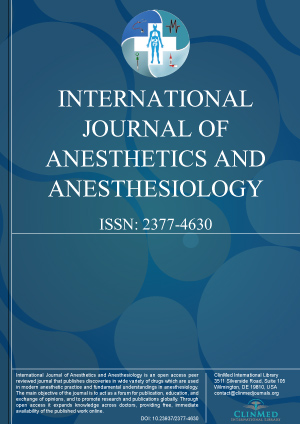Open Access DOI:10.23937/2377-4630/1410067
Interdisciplinary Anesthesia Tray Revision Project: Reducing the Opportunity for Human Error
Smith KL, Sharp C, Smith E, Currie M, Hall KP, Vu T, Lee M and Cooper RL
Article Type: Research Article | First Published: June 14, 2018
Medication errors cause an estimated 100,000 to 400,000 patient deaths in the United States annually (IOM). Previous reviews on this alarming statistic consistently identify human error as the most common etiology. The potential for medication errors is especially high risk in the operating suite, where the provider simultaneously selects, doses and verifies medications to be administered to patients. Additionally, a lack of standardization and error reduction strategies in this setting creates ...
Open Access DOI:10.23937/2377-4630/1410066
Transient Unilateral Lower Limb Palsy after Open Surgery Thoraco-Abdominal Aorta Repair
Francesco Corazzi, Stefania Brusa, Enrico Giustiniano, Efrem Civilini, Giorgio Luca Poletto and Ferdinando Raimondi
Article Type: Case Report | First Published: May 30, 2018
Anamnesis included cholecystectomy, hypertension and coronary artery by-pass graft (CABG) due to acute myocardial infarction (AMI), dislipidemia, G6PD deficit, allergy to milk proteins, liver steatosis and severe chronic obstructive pulmonary disease (COPD) with FEV1/FVC ratio 0.43 and FEV1 1.12 L (44%)....
Open Access DOI:10.23937/2377-4630/1410065
Anesthesia Implications of the Use of Essential Oils in Alzheimer's Dementia
James L Geiger
Article Type: Review Article | First Published: May 25, 2018
The diagnosis and treatment of Alzheimer's dementia (AD) has gained much attention due to the current and predicted prevalence of the disease. The biomarkers of neural inflammation, oxidative stress, genetics and the multiple medical etiologies of AD coupled with the poly-pharmacy of comorbid conditions and diseases associated with AD are complex....
Open Access DOI:10.23937/2377-4630/1410064
Analyzing Volatile Anesthetic Consumption by Auditing Fresh Gas Flow: An Observational Study at an Academic Hospital
Luis Tollinche, KaySee Tan, Austin Han , Leslie Ojea and Cindy Yeoh
Article Type: Research Article | First Published: April 26, 2018
In a climate of cost containment, it is critical to analyze and optimize all perioperative variable costs. Fresh gas flow is one important variable that determines utilization of inhalational agents and can be tightly controlled by the anesthesia provider. Manufacturers of inhalational agents have recommendations for minimum gas flow for their respective agents. Any gas flow above these recommendations is considered misuse and leads to unnecessary expense. The purpose of this study was to charac...
Open Access DOI:10.23937/2377-4630/1410063
Acute Pain Management in a Child: A Case Report of 46-Days of Popliteal Sciatic Nerve Catheter
Hertz Laurent, Sola Chrystelle, De La Arena Pablo and Dadure Christophe
Article Type: Case Report | First Published: April 25, 2018
The use of perineural catheter for more than 72 hours is rare in perioperative practice, but was especially reported for chronic pain, oncologic related pain or palliative care. The main concern remains the risk of neurological or infectious complication. No guideline clearly specifies the maximum duration of perineural catheter maintenance and the safety of long-term catheters is discussed....
Open Access DOI:10.23937/2377-4630/1410062
Perioperative Cardiac Stent Thrombosis Versus Bleeding: A Clinical Dilemma in Trauma Patients
Nwokolo Omonele O and Wegner Robert C
Article Type: Case Report | First Published: April 05, 2018
Heart disease is prevalent in current patient population at an increasing level. Some of these patients have had interventions such as stent placements to improve quality of life and are started on antiplatelet therapy for a definite period of time or indefinitely based on their risk factors, comorbidities or type of stents placed. When these patients present to the hospital with major trauma, the surgical and anesthetic management threads a delicate line between protection of the stents and pre...
Open Access DOI:10.23937/2377-4630/1410061
Phenytoin in Topical Formulations Augments Pain Reduction of Other Analgesics in the Treatment of Neuropathic Pain
David J Kopsky and Jan M Keppel Hesselink
Article Type: Case Report | First Published: February 03, 2018
Topical analgesic formulations are gaining interest for the treatment of peripheral neuropathic pain since the beginning of 2000. Advantages of topical analgesics over oral medication are the absence of systemic side effects and drug-drug interactions, higher concentrations of active compound at the pain area, fast onset on action, improvement of compliance, and no risk of abuse. In many peripheral neuropathic pain states the pain area is small and thus topical analgesics are suitable. Most pati...

